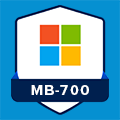
Duration: 3 Days
After completing this course, candidates will be able to:
Candidates for this exam are Microsoft Dynamics 365 professionals who advise stakeholders and
translate business requirements into secure, scalable, and reliable solutions.
Candidates should have knowledge of all Dynamics 365 apps and Power Platform. They must
have deep understanding of Finance and Operations apps. In addition, they have extensive
domain knowledge in one or more industry verticals. This role requires understanding how
decisions in each area affects the overall solution
Select a deployment strategy
Describe Lifecycle Services (LCS) tools
Define a testing strategy
A Microsoft Dynamics Certified Trainer.
£1,999+VAT
Clientele ➞























Our Partners




